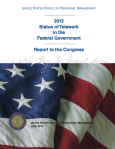Imagine coordinating information on 2.1 million employees, 87 different organizations, and 170,000 teleworkers. The Office of Personnel Management (OPM) is required to do just that.
The 2010 Telework Enhancement Act mandated government agencies to implement telework policies and the OPM to track organizational and environmental impacts. Last month, OPM released their first report, 2012 Status of Telework in the Federal Government, that establishes a baseline for future measurement of the federal program. The report provides valuable insights on how telework may be tracked. Here are the relevant topics from the report and some questions that we might ask of our mobility program:
Categorizing Objectives
A wide range of desired outcomes is described, from increased participation to reduced commute times. Articulating goals and clarifying objectives whether short term (employee participation), intermediate, or longer-term (increased retention, reduced carbon emissions) helps manage expectations and for measuring success.
Goals may be a social goal (expanding the potential workforce), an operational goal (improved emergency preparedness) or a financial goal (reducing real estate, lowering operating costs) – any which can help both communicate and build support for the program.
Key questions to ask of your mobility program:
- Have we set achievable short-term goals as well as longer-term objectives?
- Are we fine-tuning our message for our audiences? For example, communicating the workforce impact to HR and financial impact to the CFO.
- Is it time to restate or refresh our goals in order to re-invigorate enthusiasm around our programs?
Identifying Measurements to Assess Progress
You can’t manage what you don’t measure, and there are a range of measurements and data sources suggested.
The simple exercise of creating a table listing Expected Effect, Measurement, and Data Source ensures that desired outcomes have an associated metric that can be tracked. If data in a particular area is unavailable, it may indicate lack of organizational support for the associated goal, and that goal’s validity should be reassessed. Carbon footprinting is an example of a category where data, not typically collected five years ago, is increasingly tracked and available.
Key questions to ask of your program:
- Where is additional data needed, and how do we quickly establish and begin to track metrics where they are missing?
- Do other workgroups such as HR or IT have metrics that can be used to measure progress in our program?
- Have we documented and communicated progress towards both the short term and longer term goals?
Comparison of Teleworking vs Non-Teleworking Groups
Finally, the report includes extensive survey results which compare different worker groups: those that telework, those that cannot telework due to agency requirements, and those that are eligible but choose not to telework. While almost a third of those 2.1 million workers are eligible to telework, only a quarter of those eligible did in the period studied, i.e. less than 10% of the workforce. Some highlights:
- Job satisfaction was about the same between teleworkers and those who choose not to, but significantly lower for those whom it was not an option.
- Teleworkers reported a less clear understanding of their job responsibilities compared to their non-teleworking peers.
- Knowledge sharing within the work group was reported at the same level for both teleworkers and non-teleworkers.
While these outcomes will vary by organization, the goal for everyone is how to foster the positive elements and reduce the gap between the groups where there is one. We want our non-mobile workers to have job satisfaction just as high as their mobile peers, and everyone to understand their responsibilities.
Key questions to ask of your mobility program:
- Are opportunities and options being communicated to all who are eligible, and are there ways the eligibility pool can be expanded?
- Why might eligible staff for mobile work programs choose not to participate, and what is the impact for them individually and for the organization?
- How do our distributed workgroups ensure skills and information are being shared?
- Are there investments we should make in training or team-building to strengthen relationships?
An annual update is an opportunity to get out of the trenches, assess progress, and identify potential improvements. Not only can this sort of assessment re-invigorate our programs, but documenting and communicating our achievements provides an opportunity to prove our value to the organization.

